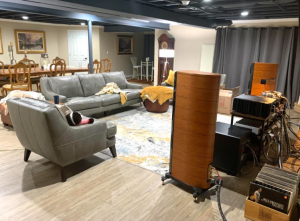Roger Skoff writes about how our eyes, ears, and wallets may all be tied together
The traffic on Pacific Coast Highway ("PCH") in Newport Beach, California is slow and awful, jammed most of the time with tourists, beach bums and bunnies, locals doing whatever they do, and others, from Orange County and elsewhere, on their way to or from work, or simply "profiling" or watching others profile. Among the cars making-up the moving mess are Ferraris, Maseratis, Rolls-Royces, and Bentleys, a seemingly near-infinite number of Mercedes, and every other kind of ordinary and exotic automobile you can imagine. And there are dealerships, too, on PCH, for most of the exotics, even including McLaren, which, other than Bugatti and Koenigsegg, is about as exotic as you can get.
All of those fancy cars—some of which can accelerate from a dead stop to 60 mph in under 3 seconds and achieve a top speed of well over 200 mph, and all of the other cars filled with people admiring them are moving along at what's usually a snail's pace, but may occasionally get all the way up to a speed that will allow them to keep up with or even pass the bicycles threading their way between them.
If you've ever seen the "DuPont Registry", which is, among other things, a sort of catalog of used expensive, rare, or exotic cars and other rich-kids-toys, you know that most of the cars offered for sale have very low mileage for their age. Maybe that's because of something silly, like spending most of their driving hours at low speed, profiling for the peasants or trying to attract the action that was promised to Jaguar owners in the movie "Crazy People," or maybe it's just that there's no place to drive a Bugatti or a Koenigsegg, or even a McLaren at 200+ miles per hour.
The fact of it is that even if you drive an econobox that has to work hard to get up to 80 mph, the maximum overall speed limit—at least here in California—is only 65, and doing that feeble 80 could get you a ticket or even thrown in jail.
With cars, unless you're a race driver, are going to drive only on the track, and have all the skills and cojones necessary to push your car to its limit, you're never going to use all of the performance your car was designed for and that you've paid so much to get. Probably not even a significant percentage of it.
So why are ultra-performance cars built? Because maybe the car or maybe the ability to pay for it bestows—at least in the owner’s own mind—huge prestige and social standing on its owner; because ultra-performance cars tend to be either very pretty or very attractively exotic-looking, which the owner may enjoy enough to pay the price for it; and because their nifty looks; their beauty; their obvious expense; and/or what they tell others about their owners might just get them those promised "Jaguar benefits" in real life.
Maybe the cars' owners are just fascinated by the idea that they can go fast, even if they never really use them to their full potential.
With high-end audio, or even just plain good mid-fi, it's completely different: Our audio equipment is always giving us its very best performance: An amplifier, for example, driving normally efficient speakers (90-ish dB sensitivity @ 1-watt/1 Meter) in a home environment may rarely, if ever, put out even one full watt of its rated output power (typically 100-300 watts for solid-state, and some fraction of that for tube gear) in normal use, and it may never actually put out a full 10 watts in its whole operating lifetime. Even so, all of its other characteristics of imaging, clarity, frequency response, freedom from distortion, transient attack and decay, and everything else, are called upon and enjoyed by us all the time, every time it's played. We do use all—except, perhaps, the most extreme volume level—of all of our audio equipment every time we listen to it, and even then the argument could be made that it's that extra power that we never draw on that let's our amps deal comfortably with the levels we do call for.
That's why, unlike drivers of the highest performance cars, we do need the highest audio performance we can get all the time, and the ability to provide it, just as with cars, is costly. And that's where a surprising parallel arises: Just as high performance cars and high performance audio are technological tours de force, and just as they both tend to cost accordingly, both must rely on not just their performance to "close the deal" and pry the money loose from their buyers' hands, but must also have a "look" and be made of materials that reassure their buyers that their high cost is justified.
I wrote, some while ago in a different publication, about how one manufacturer's gorgeous machined and ultra-thick faceplate and handles on one of his amplifiers added a full twenty percent to its retail price. When I asked him if it wouldn't be better to use just a plain or painted steel faceplate and take a big chunk off the price, he told me that for the number of thousands of dollars he would still have to charge for it, if the amplifier wasn't suitably expensive-looking, he probably wouldn't—even despite its marvelous performance—be able to sell any of them at all.
I understand that: If a Ferrari looked just like an ordinary car, would anybody buy one? Would anybody pay more than a hundred thousand dollars for a record player if the turntable, tonearm(s), plinth, and mounting base weren't gorgeous and obviously viciously expensive? Would those Goldmund Apologue Speakers or the MBL double footballs or any of the other super-exotica find buyers if they didn't look as good as they sound? If, instead, they just looked—as the Duntech Sovereigns did—like a pair of big brown refrigerators sitting in the middle of the listening room, would anybody actually buy them?
The fact of it is that in HiFi or Performance Cars or any number of other things, excellence is expensive to produce and needs to look expensive in order to sell, which means that manufacturers need to spend extra money on styling and fancy materials to sell them, which makes them still more expensive, and around and around, all of which is unfortunate—but I can live with it.
What's also understandable, but that I don't want to live with, is what seems like an ever-increasing number of audio products that are going for great looks, fancy materials, and high prices but without giving, in my humble opinion, the high performance that's supposed to be part of the package. This includes any number of product types—turntables and tonearms that are violently expensive and utterly gorgeous, but that seem to offer no sonic improvement whatsoever; ultra-exotic, ultra-expensive speakers that are only okay sounding; tube electronics that seems to have had their tube complement chosen just for the weird color of its glow or the size or peculiarity of its glassware; or even, in my own specialty area, the use of carbon fiber or exotic wood connector shells and other hardware that, other than being pretty and adding to the cables' price, I know to do nothing at all.
Did you ever hear stories about the perfectly ordinary (or even old and "ratty-looking") car that, with a concealed 1200 horsepower engine is able to blow-off all comers in a drag? I have, and I know that there really are cars like that out there. Wouldn't it be nice if there were HiFi equivalents? Stuff of utterly amazing performance that doesn't look like much and costs even less? Beauty is wonderful and I'm happy to pay for it, if I have to, but in the end, the sound is what I'm really interested in and what I really want to buy.






































